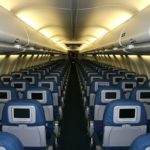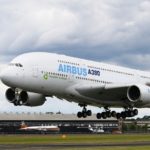Aircraft exterior cleaning also is known as aircraft exterior detailing service involves restoring the original condition of the surface of the aircraft. The exterior cleaning can be carried out using a water wash, just wash, or simply wiping the aircraft with spray cleaner and cloth. The purpose of exterior cleaning is to remove dirt, bugs, exhaust streaks, oil stains and spots from the outer surface of the aircraft body which helps to enhance the physical appearance of the aircraft and enhances the lifespan of the aircraft exterior body, paintwork, and associated components.
Aircraft Polishing Unpainted and Painted Surfaces
The aircraft unpainted surfaces, known as brightwork, require polishing to remove surface corrosion and to enhance their appearance. These areas are polished when oxidation begins to appear using an orbital buffer or by hand with a non-abrasive cleaning/polishing solution. Surrounding painted and plastic exterior surfaces (such as light lenses) are masked off to prevent damage. Surfaces are left with a mirror-like finish and all debris associated with polishing is removed. Painted surfaces require polishing to protect the high gloss exterior finish of the entire aircraft and in specific areas to remove stubborn stains, typically around exhaust areas.
Aircat Polishing Unpainted Aluminum
Polishing unpainted aluminum is a must job when considering aircraft exterior cleaning. All areas are polished including the leading edges of the aircraft wings, horizontal and vertical stabilizers, engine inlets, and the cockpit window frames. The areas are masked off to prevent damage to painted surfaces. The aluminum is polished either by hand or by using orbital buffers, non-abrasive pads and a non-abrasive aluminum cleaning polish. All exterior cleaning processes meet the manufacturer’s specifications.
Cleaning Methods
For aircraft exterior cleaning there are three major methods; wet wash, dry wash, and polishing. Polishing can be either done manually by hand or the polishing activity can be performed using specialized mechanical polishing machines. The cleaning service that you choose will give you the extent of soiling and the final desired appearance in the result.
Wet Wash
The aircraft wet wash is useful for removing oil, grease, or carbon deposits and most soils. This method, however, can add very little or no value to the remediation of corrosion and oxide films. In this method cleaning components are sprayed or moped over the aircraft exterior and then high water pressure wash is used to rinse the surface of the aircraft. Predominantly, alkaline or emulsion cleaning products can be used in this method of cleaning.
Dry Wash
The aircraft dry wash is used when the goal is to remove airport film, dust, and small accumulations of dirt and soil. Dry wash is used in cases when the use of liquids is not suitable. This is important to understand that dry wash method is not suitable for removing heavy deposits of carbon, grease, or oil, especially in the engine exhaust areas. Dry wash materials are applied with spray, mops, or cloths, and removed by dry mopping or wiping with clean, dry cloths.
Polishing
Polishing restores the lustre to painted and unpainted surfaces of the aircraft and is usually performed after the surfaces have been cleaned. Polishing is also used to remove oxidation and corrosion. Polishing materials are available in various forms and degrees of abrasiveness. It is important that the aircraft manufacturer’s instructions be used in specific applications.
Cleaning Standards
All cleaning work meet the standards required by the airlines and is accomplished in conformance with approved and accepted standards of the industry; equipment manufacturers. All applicable building and safety codes, as well as the aircraft manufacturer’s recommended cleaning and servicing instructions, are followed.






